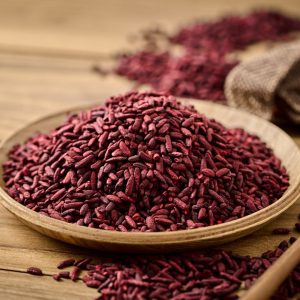 Red yeast rice: A traditional fermented food with modern clinical relevance
Red yeast rice: A traditional fermented food with modern clinical relevance
Exploring a natural approach to cholesterol support
Red yeast rice has been used for centuries in traditional Chinese medicine and cuisine. More recently, it’s gained interest as a gentle, evidence-informed option for supporting healthy cholesterol levels. If you’re exploring natural ways to support your cardiovascular health, you may have come across red yeast rice and wondered how it works and whether it’s worth considering.
What is red yeast rice?
Red yeast rice is made by fermenting white rice with a specific yeast strain (Monascus purpureus). During fermentation, the yeast produces several naturally occurring compounds—most notably monacolin K, which helps regulate cholesterol production.
Monacolin K is structurally identical to lovastatin, a prescription statin. However, in red yeast rice, it’s present in lower concentrations and accompanied by a matrix of other naturally occurring compounds such as sterols, isoflavones and monounsaturated fats. These may provide additional metabolic and vascular support beyond the monacolin K itself.
How does it support cholesterol?
Monacolin K works by modulating the activity of HMG-CoA reductase, an enzyme involved in cholesterol synthesis. By gently slowing this internal production pathway, red yeast rice can help support healthy LDL (“bad”) cholesterol levels—especially when combined with supportive lifestyle measures like sufficient dietary fibre, regular exercise and a balanced diet.
Clinical studies using standardised red yeast rice preparations have shown reductions in LDL cholesterol comparable to those seen with low-dose statin therapy. However, results vary depending on the quality and composition of the product.
What should you look for?
In Australia, red yeast rice supplements must comply with strict regulations, meaning they typically contain lower levels of monacolin K than pharmaceutical products. In contrast, some overseas supplements may contain higher amounts and are often less tightly regulated. This can lead to inconsistencies in potency and, in some cases, safety.
For this reason, it’s worth choosing a red yeast rice product from a reputable brand that ensures consistency, purity and quality control.
Is it suitable for everyone?
Most people tolerate red yeast rice well. It may be worth considering for those with modestly elevated cholesterol who are seeking a food-based option before turning to prescription therapies.
That said, red yeast rice may not be appropriate in every situation. People with known liver conditions, those who have experienced sensitivity to statins in the past or anyone taking cholesterol-lowering medications should speak with their healthcare provider before introducing red yeast rice. This helps ensure any supplement fits safely within their broader health context.
Who might consider it?
Red yeast rice may be a helpful option if:
- You’re looking for a gentle, natural approach to cholesterol support
- You’ve been advised to explore dietary and supplement strategies before prescription treatment
- You’re seeking a traditionally used food-based supplement supported by clinical research
As with any cardiovascular strategy, red yeast rice is most effective when paired with healthy lifestyle foundations—nutrient-dense meals, movement, quality sleep and stress support.
The bottom line
Red yeast rice is a traditional fermented food with modern clinical relevance. It may offer a gentle way to support healthy cholesterol metabolism—particularly LDL—when included as part of a broader lifestyle approach.
As with any cholesterol-lowering strategy, individual factors matter—including diet, genetics, other medications and overall risk profile. If you’d like to explore whether red yeast rice is the right option for you, come in for a chat with our qualified team. For more personalised support, you can also book a consultation at www.viveclinic.com.au
Article written by
Peter Christinson
BHSc (Nutritional and Dietetic Medicine)
Retail and Clinic Manager
